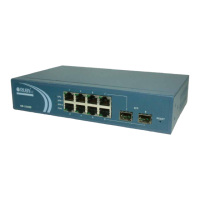GS-2108C User Manual
Publication date: April, 2008
Revision A4
71
3-6. Loop Detection
The loop detection is used to detect the presence of traffic. When switch
receives packet’s(looping detection frame) MAC address the same as oneself from
port, show Loop detection happens. The port will be locked when it received the
looping detection frames. If you want to resume the locked port, please find out the
looping path and take off the looping path, then select the resume the locked port
and evoke “Unlock” on “Resume Action” to turn on the locked ports.
Fig. 3-24
Function name:
Loop Detection
Function description:
Looping will always occur when the switches are connected as a cycle
and a switch transmits the packets that will go back to the transmitted switch.
Loop Detection will prevent the looping from happening. Moreover, it could
remove the looping phenomenon per port. In general, you can unplug the
cable connection to stop the looping when a port causes the looping. The
switch has powerful Looping Detection capability, which could cease the
looping immediately.
This function will start when you enable looping action by ticking the check box
(;) of the Action. That will create some special packet for looping detection.
After enabling looping action, you should decide which port you would like to
open loop detection capability. For example, you open the loop detection of
port 1 as enable state. When the looping situation happens from port 1, Loop
Detection will lock the port1’s ability. And then you will see that the “Current
Status” of port 1 shows Locked. In port status function, you can see that the
State of Port Configuration of port 1 is “Disabled”. So the port 1 will lose the
essential ability the port could have. However, “Resume Action” in Loop
Detection will remove the looping status. It is very convenient for looping

